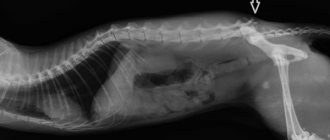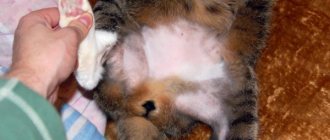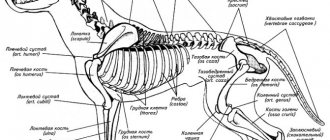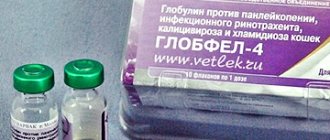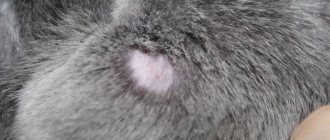Answer
If these symptoms occur, do not self-medicate; you should immediately contact a veterinarian. The owner takes full responsibility for the life and condition of the dog, including carrying out the necessary prevention and treatment of diseases.
Due to human negligence, the dog runs the risk of death. If at the moment it is not possible to go to the hospital, we will analyze the symptoms separately in order to find possible causes.
How to help your pet?
It is very important not to self-medicate so as not to aggravate the problem. If a paw is broken, the pelvic bones or spine are damaged, urgent surgery may be needed, so delaying is very dangerous for the dog. “Human” drugs can also cause serious harm, especially to small individuals, due to the large dosage. If a large breed dog needs treatment for arthrosis of the hip joint, massage and thermal treatments are also contraindicated for it and can be harmful.
Do not give your dog an anesthetic before visiting the veterinarian, so as not to distort the picture of the disease. It is necessary to take the animal to the doctor in an immobilized state. Otherwise, the dog may cause broken bones to dislodge, damage nerves or blood vessels, which will lead to bleeding. The veterinarian will take an x-ray or ultrasound, perform other diagnostic procedures and prescribe treatment.
If your dog doesn't have problems with his hind legs, do exercises to improve his coordination.
Blood in urine
The normal color of urine is straw-yellow, without impurities. A change in color, especially the appearance of red, signals a pathological process, with the exception of the consumption of coloring products, for example, beets.
Causes of blood in urine:
- Getting injured. If the animal was exposed to external influences, damage to bones or organs could result. Usually this is immediately noticeable in the dog’s appearance - there is a change in weight distribution, depending on the factor causing pain, the posture changes. Look at how the animal lies - a healthy dog lies at ease, stretched out and stretching out its paws. If there is discomfort, the dog will move to the side, taking unnatural positions or unusual for previously.
- Parasitic diseases. Infection with parasites and infectious diseases also cause blood to enter the urine. The dog's appetite decreases and body temperature rises, the mucous membranes turn pale or yellow.
- Tumors and inflammations. Diseases of the internal organs or any formations in the animal’s body can provoke the appearance of bloody impurities in the urine.
Causes of weak hind legs in dogs
There are 5 groups of reasons that are typical for animals of certain breeds:
1. Destruction or displacement of intervertebral discs.
The pathology is more common in Pekingese, pugs, bulldogs, dachshunds and poodles. Due to displacement or damage, the spinal cord is compressed and injured, so urgent veterinary help is required, otherwise there is a risk of death. The disease can be recognized by acute pain in a pet whose legs give way and any movement causes trembling or shortness of breath.
2. Diseases of the hip joints.
Treatment of arthrosis of the hip joint is most often prescribed for dogs of large breeds - Rottweiler, Alabai, Caucasian, German Shepherd. The reason is excess weight, lack of sufficient physical activity, infectious diseases, injuries.
Too active training is harmful for puppies - jumping from heights, running long distances, due to injury to the joints. Arthrosis is more often diagnosed in animals older than eight years. If weakness in the hind legs occurs in the morning and then disappears, the veterinarian may suspect arthrosis.
3. Myositis.
Inflammation of muscle tissue occurs in dogs of all breeds the day after heavy physical activity. The animal moves as if on stilts.
4. Brain lesions.
Due to shock, symptoms of injury may not appear immediately. Therefore, if an animal is injured, it must be shown to a veterinarian even in the absence of clinical signs.
Tumors and vascular pathologies also affect the firmness of gait. To diagnose them, a special examination is necessary.
5. Injuries.
What actions to take
With the above-mentioned symptoms, it is impossible to provide independent treatment for the animal, since it is necessary to take a blood test to identify the presence (or absence) of internal inflammatory processes in the animal. If there is pain in the paws and spine, an x-ray must be taken immediately. The obvious presence of bloody impurities in a dog’s urine is an abnormal phenomenon, and drinking too much is a consequence of dehydration from bowel disorders. We consider it mandatory advice to take your pet to the veterinarian as soon as possible for emergency care.
Why can a dog lose its hind legs?
If the animal shows signs of weakness, you should not wait until the paws are taken away: prompt assistance from a veterinarian can save the dog’s life.
Dogs' hind legs are lost for the following reasons:
- genetic disorders (especially among breeds with a long body and short legs, which were inherited through selective selection of pathology of the spine and the structure of the pelvic bones);
- arthritis and arthrosis (when moving, nerve endings are pinched, the animal limps, the hind legs give way);
- tumors in close proximity to the spine, pelvic bones and hip joints, pinching the nerves that control the movement of the paws;
- injuries (fractures, sprains, tendon ruptures lead to complete or partial paralysis).
It is necessary to minimize the risk of injury to the dog in the apartment.
Necessary prevention
To ensure that your puppy grows up to be a healthy dog with a good musculoskeletal system, you should adhere to several rules:
- follow the correct diet;
- add only necessary additives to food in reasonable quantities;
- raise the puppy correctly, without overloading it with unnecessary physical activity.
Almost all puppies are born with perfect limbs, but problems can occur in the future. As a responsible German Shepherd owner, it is your responsibility to properly care for your dog. You must not only feed your puppy properly, but also make sure that he does not overeat. When the baby begins to stand on his paws, excess weight can immediately damage the joints.
Remember to keep an eye on where puppies play. The surface must be smooth and non-slippery, without obstacles or drafts. The puppy should not be given much physical activity. Also, do not bandage the dog’s limbs, disrupting blood circulation.
Just let the puppy grow up in normal conditions, and everything will be fine.
Have you ever encountered the problem of weak paws in your shepherd? What was the reason?
What not to do
The most common mistake owners make when identifying hind limb weakness is to self-treat dogs with non-steroidal anti-inflammatory drugs (diclofenac, indomethacin, aspirin, etc.). The clinical improvements observed by the owners after the use of these medications are only temporary, but they well hide the underlying disease, which significantly complicates the correct diagnosis of the disease due to which the dog is losing its hind legs. Also, medical anti-inflammatory drugs have a number of serious side effects for pets, including ulcers on the walls of the stomach and bleeding in it.
What to do if your German Shepherd has limb failure
The causes of dysfunction of the musculoskeletal system in puppies and adult German Shepherds can be various pathologies that require specific treatment.
Pathologies of the joints of the limbs: injuries, arthritis, arthrosis and dysplasia
Arthritis and arthrosis most often occur in middle-aged and elderly people. Dysplasia of the elbow and hip joints can occur in shepherd dogs of any age category.
Dysplasia is a chronic disease accompanied by destruction of the dog’s joints, ruptures of cartilage and bone tissue. With the hereditary nature of the pathology, animals have a congenital anomaly in the structure of the articular surfaces of the bones. Symptoms of the disease begin to appear in puppies no earlier than 6 months.
In BUTs, a smooth line should be visible from the tips of the ears to the hind legs; a hunchbacked back indicates the presence of dysplasia
Acquired dysplasia can occur in animals of any age. Occurs when feeding is disrupted, lack or excess of vitamin and mineral supplements, obesity or excessive physical activity at a young age. In pathology, the following is observed:
- lameness;
- dislocations;
- paw instability;
- fast fatiguability;
- difficulty getting up from a lying position;
- enlargement and cracking of joints.
In case of a mild stage of the disease, the specialist prescribes to the patient:
- diet;
- limiting physical activity;
- physiotherapy;
- chondroprotectors and painkillers.
A severe stage of the disease requires surgical intervention using resection arthroplasty and triple osteotomy.
Dysplasia can be completely cured through the use of expensive prostheses installed surgically.
Spine pathologies
Bruises, discopathy, spondylosis, spondyloarthrosis, osteochondrosis occur with damage to the fibrous rings of the vertebrae, swelling and compression of the spinal cord and peripheral nerves. As a result, the cells of the nervous system die off, manifested in weakness of the paws:
- shuffling;
- lameness;
- clawing or complete failure of the limbs.
Spinal injuries sometimes lead to complete paralysis of the hind limbs.
Treatment of spinal diseases depends on the stage of the pathology and the advanced stage of the disease; the four-legged patient is prescribed rest, anti-inflammatory, painkillers and hormonal drugs, and sometimes surgical intervention is indicated.
Oncological diseases
Impaired performance of the musculoskeletal system is observed when neoplasms of a malignant and benign nature occur on the limbs, spine, spinal cord and brain. Tumors compress the surrounding tissues and structures of the central nervous system or grow into them. In middle-aged and elderly German Shepherds, swelling may appear on the paws, and the dog may limp or drag its limbs. When the tumor is localized in the spinal cord or brain, severe pain, paresis or complete paralysis of the limbs is observed.
Oncology on the paw BUT
The success and expediency of treatment directly depends on the timeliness of contacting a specialist, the correctness of the diagnosis and the nature of the tumor. Malignant tumors and neoplasms in the brain and spinal cord cannot be treated; in such cases, it is wiser to euthanize the animal or keep the pet alive with painkillers and hormonal drugs.
Injuries
Impaired performance of the limbs occurs due to various injuries to the paws, spine and skull, which the animal can receive during games, fights, walking or a collision between the dog and a vehicle. A German Shepherd can suffer a dislocation, bruise, sprain, open or closed fracture of a limb, spine or skull.
Fixing bandages are used to treat bruises, sprains and fractures
When injuries occur:
- swelling of the damaged area;
- hematomas form;
- the animal whines, tightens its limb;
- Sometimes he can't step on his paw.
If the cause of limb weakness is injury, the animal is taken to a specialist in a recumbent position. The dog's body must be fixed to avoid deformation of the damaged spine. For this purpose, you can use boards or wooden shields and elastic bandages.
Treatment for injuries depends on the nature of the injury. Dislocated joints are reduced. For bruises, sprains and closed fractures, fixing bandages, painkillers and physiotherapy are used. Open injuries require surgical intervention; if the integrity of the spinal cord or brain is damaged, it is impossible to cure the pet.
Introduction
There is no single reason that can cause such symptoms.
Dog veterinary evidence suggests that the first step in treatment should be qualified diagnosis. To know how to treat, you need to know what to treat. And you can’t do this without a trip to the veterinarian. Individual pathologies when a dog loses its hind legs include age and breed predisposition. Thus, pugs, poodles, English and French bulldogs, dachshunds and Pekingese have a predisposition to the destruction or displacement of intervertebral discs (disc herniation).
Causes
- Intervertebral disc disease (IVDD): sudden onset of ataxia or paralysis in adult dogs of any age and is often associated with severe back pain;
- Paralysis due to ticks : If your dog lives near bushes or woods, he may get paralysis of his hind legs from a tick;
- Lumbosacral stenosis : slowly progressive loss of function of the hind legs due to pressure on the spine from a narrowing at the last spinal joint;
- Fibrocartilaginous embolism : sudden loss of hind leg function without pain, predominantly in large breeds, caused by a small piece of cartilage that blocks an artery;
- Polyradiculoneuritis : an autoimmune nerve disease believed to be caused by exposure to bacteria from raw chicken;
- Degenerative myelopathy : slowly progressive loss of paw function, seen especially in medium to large older dogs;
- Snake bite : The first signs of a snake bite may be that the dog does not stand up on its hind legs, but the signs then progress quickly;
- Discospondylitis : infection by bacteria or fungi in a spinal joint and more commonly in large young dogs;
- Fractures and injuries : Spinal injuries are rare in groomed dogs, but can occur due to an accident;
- Eating calcium-deficient diets : This spinal collapse was once common in home diets but is now very rare through a balanced diet, which is widely used;
- Toxins and poisons : examples are grapes, recreational drugs (especially cannabis) and many human drugs;
- Botulism : An extremely rare paralysis caused by a toxin from bacterial contamination of food;
- Myasthenia gravis : an autoimmune disease that attacks the neuromuscular junction, also extremely rare;
- Low blood sugar : rare except in diabetics who take too much insulin;
© shutterstock
